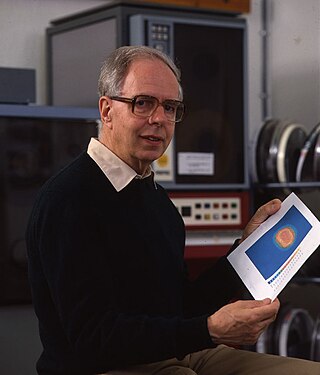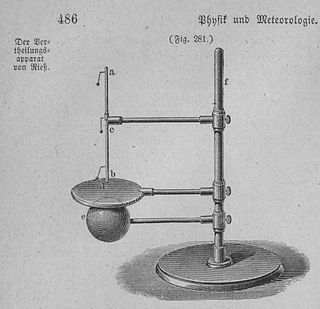Related Research Articles

Frequency is the number of occurrences of a repeating event per unit of time. It is also occasionally referred to as temporal frequency for clarity and to distinguish it from spatial frequency. Frequency is measured in hertz (Hz) which is equal to one event per second. Ordinary frequency is related to angular frequency by a scaling factor of 2π. The period is the interval of time between events, so the period is the reciprocal of the frequency.

Heinrich Rudolf Hertz was a German physicist who first conclusively proved the existence of the electromagnetic waves predicted by James Clerk Maxwell's equations of electromagnetism. The unit of frequency, cycle per second, was named the "hertz" in his honor.

The hertz is the unit of frequency in the International System of Units (SI), equivalent to one event per second. The hertz is an SI derived unit whose expression in terms of SI base units is s−1, meaning that one hertz is the reciprocal of one second. It is named after Heinrich Rudolf Hertz (1857–1894), the first person to provide conclusive proof of the existence of electromagnetic waves. Hertz are commonly expressed in multiples: kilohertz (kHz), megahertz (MHz), gigahertz (GHz), terahertz (THz).

Radio waves are a type of electromagnetic radiation with the longest wavelengths in the electromagnetic spectrum, typically with frequencies of 300 gigahertz (GHz) and below. At 300 GHz, the corresponding wavelength is 1mm, which is shorter than a grain of rice. At 30 Hz the corresponding wavelength is ~10,000 kilometers longer than the radius of the Earth. Like all electromagnetic waves, radio waves in a vacuum travel at the speed of light, and in the Earth's atmosphere at a slightly lower speed. Radio waves are generated by charged particles undergoing acceleration, such as time-varying electric currents. Naturally occurring radio waves are emitted by lightning and astronomical objects, and are part of the blackbody radiation emitted by all warm objects.

Gustav Ludwig Hertz was a German experimental physicist and Nobel Prize winner for his work on inelastic electron collisions in gases, and a nephew of Heinrich Rudolf Hertz.

Carl Hellmuth Hertz was a German physicist known primarily for being involved in the development of inkjet technology and ultrasound technology. He was the son of Gustav Ludwig Hertz and great nephew of Heinrich Hertz.

A spark-gap transmitter is an obsolete type of radio transmitter which generates radio waves by means of an electric spark. Spark-gap transmitters were the first type of radio transmitter, and were the main type used during the wireless telegraphy or "spark" era, the first three decades of radio, from 1887 to the end of World War I. German physicist Heinrich Hertz built the first experimental spark-gap transmitters in 1887, with which he proved the existence of radio waves and studied their properties.

The Submillimeter Telescope (SMT), formerly known as the Heinrich Hertz Submillimeter Telescope, is a submillimeter wavelength radio telescope located on Mount Graham, Arizona, US. It is a 10-meter-wide parabolic dish inside a building to protect it from bad weather. The building front doors and roof are opened when the telescope is in use. The telescope's construction was finished in 1993. Along with the 12 Meter Telescope on Kitt Peak, this telescope is maintained by the Arizona Radio Observatory, a division of Steward Observatory at the University of Arizona.

The cycle per second is a once-common English name for the unit of frequency now known as the hertz (Hz). Cycles per second may be denoted by c.p.s., c/s, or, ambiguously, just "cycles". The term comes from repetitive phenomena such as sound waves having a frequency measurable as a number of oscillations, or cycles, per second.

NGC 3521 is a flocculent intermediate spiral galaxy located around 26 million light-years away from Earth in the constellation Leo. It has a morphological classification of SAB(rs)bc, which indicates that it is a spiral galaxy with a trace of a bar structure (SAB), a weak inner ring (rs), and moderate to loosely wound arm structure (bc). The bar structure is difficult to discern, both because it has a low ellipticity and the galaxy is at a high inclination of 72.7° to the line of sight. The relatively bright bulge is nearly 3/4 the size of the bar, which may indicate the former is quite massive. The nucleus of this galaxy is classified as an HII LINER, as there is an H II region at the core and the nucleus forms a low-ionization nuclear emission-line region.

NGC 1309 is a spiral galaxy located approximately 120 million light-years away, appearing in the constellation Eridanus. It is about 75,000 light-years across, and is about 3/4s the width of the Milky Way. Its shape is classified as SA(s)bc, meaning that it has moderately wound spiral arms and no ring. Bright blue areas of star formation can be seen in the spiral arms, while the yellowish central nucleus contains older-population stars. NGC 1309 is one of over 200 members of the Eridanus Group of galaxies.
John Daniel Kraus was an American physicist known for his contributions to electromagnetics, radio astronomy, and antenna theory. His inventions included the helical antenna, the corner reflector antenna, and several other types of antennas. He designed the Big Ear radio telescope at Ohio State University, which was constructed mostly by a team of OSU students and was used to carry out the Ohio Sky Survey. Kraus held a number of patents and published widely.

Johann Friedrich Wilhelm von Bezold was a German physicist and meteorologist born in Munich, Kingdom of Bavaria. He is best known for discovering the Bezold effect and the Bezold–Brücke shift.

Heinrich Rubens was a German physicist. He is known for his measurements of the energy of black-body radiation which led Max Planck to the discovery of his radiation law. This was the genesis of quantum theory.

A treatise is a formal and systematic written discourse on some subject concerned with investigating or exposing the principles of the subject and its conclusions. A monograph is a treatise on a specialized topic.
The IEEE Heinrich Hertz Medal was a science award presented by the IEEE for outstanding achievements in the field of electromagnetic waves. The medal was named in honour of German physicist Heinrich Hertz, and was first proposed in 1986 by IEEE Region 8 (Germany) as a centennial recognition of Hertz's work on electromagnetic radiation theory from 1886 to 1891. The medal was first awarded in 1988, and was presented annually until 2001. It was officially discontinued in November 2009.
Leopold B. Felsen was a electrical engineer and physicist known for studies of Electromagnetism and wave-based disciplines. He had to flee Germany at 16 due to the Nazis. He has fundamental contributions to electromagnetic field analysis.
Agnes Ellinor Knochenhauer is a Swedish curler who competed at 5 World Curling Championships and at the 2014 Winter Olympics in Sochi and 2018 Winter Olympics in Pyeongchang, winning a silver and a gold medal respectively.

Peter Theophil Riess was a German physicist, known mostly for his work in electricity, particularly friction electricity, but also in the field of electromagnetic induction. In the latter work he developed two devices, the spark micrometer and the Riess spiral coils, both of which were used by Heinrich Hertz in his experiments to prove the propagation of electromagnetic waves.

The spark micrometer, also known as a Riess micrometer was a device used by 19th century physicists to measure potential in an electric circuit. It was developed principally by German physicist Peter Riess. It consisted of two electrodes very close together, one of which was attached to a micrometer screw with a calibrated dial, so by turning a knob the width of the gap could be adjusted very precisely. From Paschen's law, the distance between two electrodes when a spark just jumped across a gap was proportional to the potential difference (voltage) between the electrodes, so a spark micrometer could serve as a crude voltage measuring instrument, by widening the gap until the voltage was just able to jump across.
References
- ↑ Jed Buchwald, The Creation of Scientific Effects: Heinrich Hertz and Electric Waves, 1994: Ch. 14: "A Novel Device", p. 219.